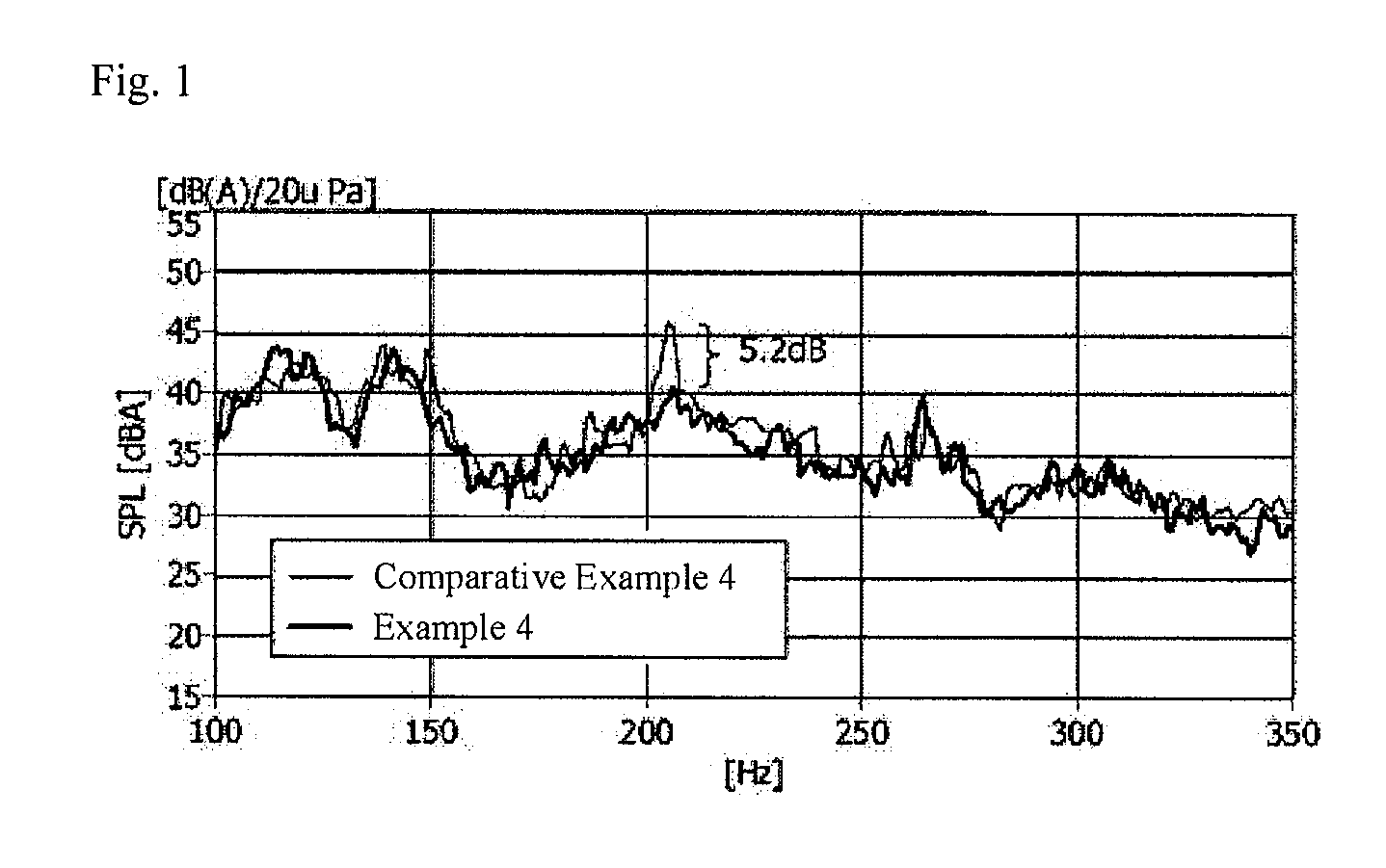Polyurethane foam and pneumatic tire
a technology of polyurethane foam and pneumatic tires, which is applied in the direction of special tyres, transportation and packaging, tyre parts, etc., can solve the problems of increasing the importance of tire cavity resonance noise, deteriorating driving comfort, and unsatisfactory driving experience for drivers, so as to improve durability and reduce the effect of resonance noise in the tire cavity
- Summary
- Abstract
- Description
- Claims
- Application Information
AI Technical Summary
Benefits of technology
Problems solved by technology
Method used
Image
Examples
experiment example 1
[0054]The hardness decrease rate and the 25% ILD of the various polyurethane foams produced in the Examples 1 to 3 and Comparative Examples 1 to 3 were measured in the following manner. The results are presented in the following Table 2.[0055]25% ILD: A polyurethane foam specimen having a thickness of 50 mm was pressed up to 75% with a circular pressing plate having a predetermined size, at a predetermined rate, and then the load was removed. The polyurethane foam specimen was pressed again up to 25%, and the load after 20 seconds was measured as a hardness value.[0056]Hardness decrease rate: The relative decrease in hardness was calculated from the results obtained as described above.
TABLE 2ComparativeComparativeComparativeExampleExampleExampleExample 1Example 2Example 3123Hardness9.17.35.65.02.32.1decrease rate(Durability)25% ILD192122403528
[0057]It can be seen from the results of Table 2 that the polyurethane foams produced in Examples 1 to 3 of the present invention have improve...
experimental example 2
[0059]The noise characteristics of the respective pneumatic tires produced according to Example 4 and Comparative Example 4 were analyzed in the following manner. The results are presented in FIG. 1.[0060]Analysis of noise characteristics: The analysis was made by a method of measuring the noise from the driver's seat during a performance verification test.
[0061]As can be seen from FIG. 1, when the polyurethane foam according to the present invention was applied to a pneumatic tire, and it was evaluated whether an improvement was made on the resonance noise, it was found that an effect of improvement was obtained on the reduction of the resonance noise by 5.2 dB at 210 Hz, which is in the low frequency region.
experiment example 3
[0062]The adhesive strength of each of the pneumatic tires produced in the Examples 4 to 6 and Comparative Examples 4 to 6 was measured in the following manner. The results are presented in Table 3.[0063]Adhesive strength: The adhesive strength was measured six times using a tack tester, and then the average adhesive force was calculated.
TABLE 3ComparativeComparativeComparativeExampleExampleExampleExample 4Example 5Example 6456Adhesive6575910strength (kgf)
[0064]It can be seen from Table 3 that when the polyurethane foams according to the present invention were applied to pneumatic tires, the adhesive strength was enhanced.
PUM
| Property | Measurement | Unit |
|---|---|---|
| diameter | aaaaa | aaaaa |
| frequency | aaaaa | aaaaa |
| weight | aaaaa | aaaaa |
Abstract
Description
Claims
Application Information
 Login to View More
Login to View More - R&D
- Intellectual Property
- Life Sciences
- Materials
- Tech Scout
- Unparalleled Data Quality
- Higher Quality Content
- 60% Fewer Hallucinations
Browse by: Latest US Patents, China's latest patents, Technical Efficacy Thesaurus, Application Domain, Technology Topic, Popular Technical Reports.
© 2025 PatSnap. All rights reserved.Legal|Privacy policy|Modern Slavery Act Transparency Statement|Sitemap|About US| Contact US: help@patsnap.com

